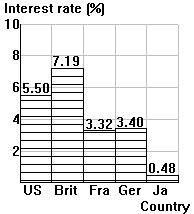| Basic theory:
The interest parity condition (IPC) is based on international transactions involving
financial assets. The logic is that, in a world of perfectly mobile financial assets,
similarly risky assets everywhere should ultimately yield the same expected return to
investors. When comparing returns across countries, both interest rates and expected
exchange-rate changes play a role. The interest parity condition states the relationship between interest rates and expected exchange-rate changes which ensures equality of expected returns across countries: Expected %DE = ifor - idom. Three situations can arise:
|
||||||||||||||
The bottom-line implication of the IPC: Whenever we see a low interest rate at home compared to abroad, savers must expect that the domestic currency is going to appreciate, and whenever we see a high interest rate at home compared to abroad, savers must expect that the domestic currency is going to depreciate. And the amount of expected currency adjustment matches the interest-rate differential. |
||||||||||||||
| Applying the interest parity condition: Consider the following information about the annual percentage rates of inctest on domestic and foreign interest on 3-month government bonds as of mid-October 1997: | ||||||||||||||
 |
||||||||||||||
| Use the interest parity condition to estimate the expected annual rate of dollar appreciation (%DE>0) or depreciation (%DE<0) as of mid-October 1997: | ||||||||||||||
|
||||||||||||||